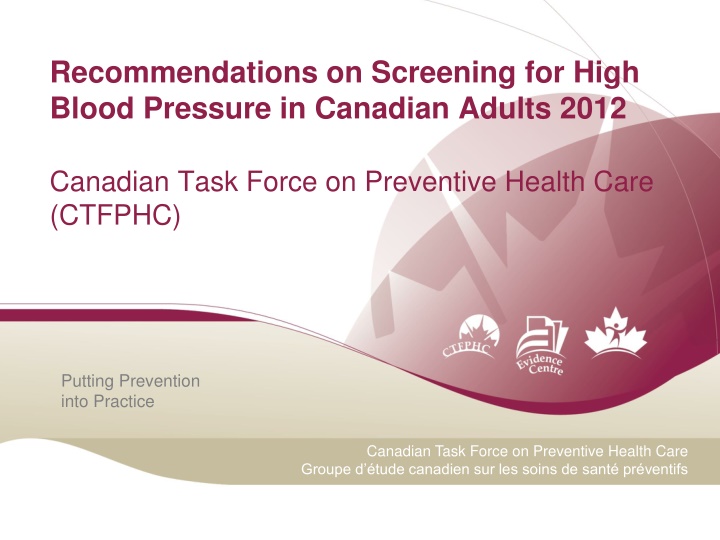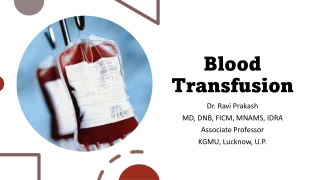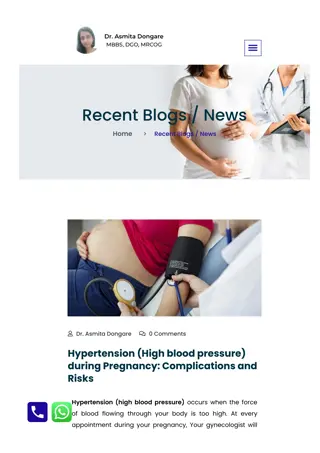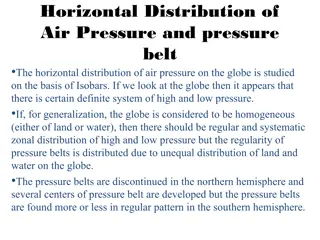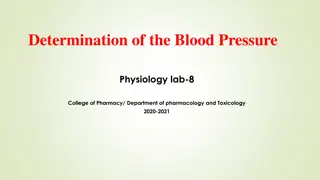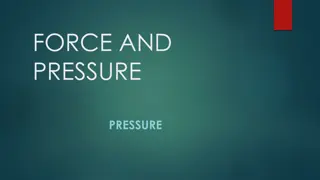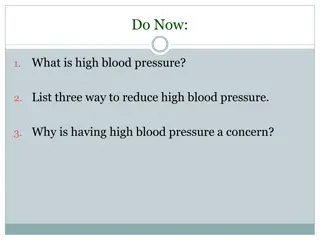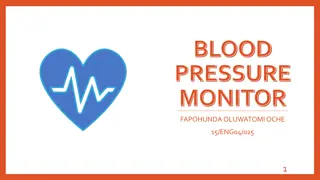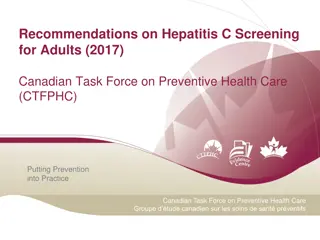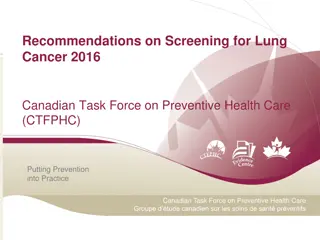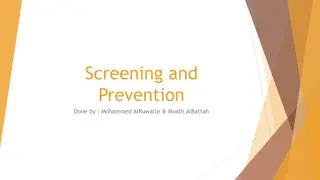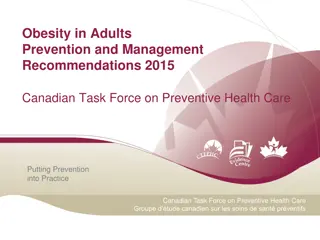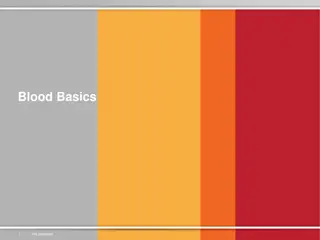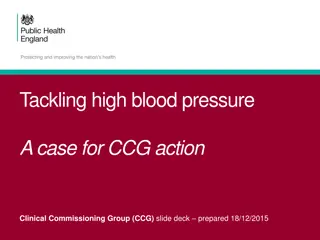Recommendations on Screening for High Blood Pressure in Canadian Adults 2012
This presentation by the Canadian Task Force on Preventive Health Care provides insights into hypertension screening, prevalence, risk factors, and recommendations for adults in Canada. It covers background information, key findings, implementation strategies, and more.
Download Presentation

Please find below an Image/Link to download the presentation.
The content on the website is provided AS IS for your information and personal use only. It may not be sold, licensed, or shared on other websites without obtaining consent from the author.If you encounter any issues during the download, it is possible that the publisher has removed the file from their server.
You are allowed to download the files provided on this website for personal or commercial use, subject to the condition that they are used lawfully. All files are the property of their respective owners.
The content on the website is provided AS IS for your information and personal use only. It may not be sold, licensed, or shared on other websites without obtaining consent from the author.
E N D
Presentation Transcript
Recommendations on Screening for High Blood Pressure in Canadian Adults 2012 Canadian Task Force on Preventive Health Care (CTFPHC) Putting Prevention into Practice Canadian Task Force on Preventive Health Care Groupe d tude canadien sur les soins de sant pr ventifs
Use of slide deck These slides are made available publicly as an educational support to assist with the dissemination, uptake and implementation of the guidelines into primary care practice. Some or all of the slides in this slide deck may be used in educational contexts. 2
CTFPHC Hypertension Working Group Members Dr. Patrice Lindsay (Chair, Hypertension WG) Dr. Richard Birtwhistle Dr. Michel Joffres Dr. Don McKay (CHEP representative) Dr. Lyne Cloutier (CHEP representative) Dr. Sarah Connor Gorber (non-voting Member) 3
Overview of Presentation Background on Hypertension Methods of the CTFPHC Recommendations and Key Findings Implementation of Recommendations Conclusions Questions and Answers 4
Screening for Hypertension BACKGROUND 5
Background Hypertension is present in an estimated 4.6 million Canadian adults, or 19% of the adult population. The prevalence of hypertension is nearly identical between men (19.7%) and women (19.0%) but rises rapidly with age, from 2% of 20 39 year olds to 53% of 60 79 year olds. Hypertension is a risk factor for stroke, myocardial infarction, and other diseases. The cause of hypertension is thought to be multifactorial. Obesity, sedentary lifestyle, poor diet with excess intake of salt and alcohol are major contributors. The usual screening test for hypertension is measurement of blood pressure as part of routine medical practice. 6
Screening for Hypertension Any blood pressure measurement by any equipment in any setting, includes: Office BP measurement Home BP measurement Ambulatory blood pressure monitoring 7
Screening for Hypertension METHODS 8
Methods of the CTFPHC Independent panel of: Clinicians and methodologists Expertise in prevention, primary care, literature synthesis, critical appraisal, and application of evidence to practice and policy Hypertension Working Group 3 Task Force members and 2 non-voting members of Canadian Hypertension Education Program (CHEP) Establish research questions and analytical framework Review and interpret evidence Propose recommendations 9
Methods of the CTFPHC Evidence Review and Synthesis Centre (ERSC) Undertook a systematic review of the literature based on the analytical framework Prepared a systematic review of the evidence with GRADE tables Participated in working group and task force meetings Obtained expert opinions 10
CTFPHC Review Process Internal review process involving guideline working group, Task Force, scientific officers and ERSC staff External review process involving key stakeholders Generalist and disease specific stakeholders Federal and P/T stakeholders CMAJ undertakes an independent peer review journal process to review guidelines 11
Research Questions The systematic review for screening for hypertension (ambulatory, office or home blood pressure measurements) included: (3) key research question with (2) sub-questions (6) supplemental or contextual questions For more detailed information please access the systematic review www.canadiantaskforce.ca 12
Eligible Study Types Population: Adults (18+), including subsets with higher than average risk of hypertension, cardiovascular risk, and average baseline blood pressure. Excluded were children and adolescents; individuals with established or documented cardiovascular disease Population groups at high risk include: family history of hypertension, individuals of African ancestry; individuals with other vascular risk factors including dyslipidemia, diabetes mellitus, obesity Language: English, French Study type: Randomized control trials (RCTs), systematic reviews and observational studies (case control and cohort) Outcomes: For benefits new diagnosis of hypertension, systolic and diastolic blood pressure, cardiovascular morbidity. For harms harms of screening and identification of HTN 14
How is Evidence Graded? The GRADE System: Grading of Recommendations, Assessment, Development & Evaluation What are we grading? 1. Quality of Evidence Degree of confidence that the available evidence correctly reflects the theoretical true effect of the intervention or service. high, moderate, low, very low 2. Strength of Recommendation the balance between desirable and undesirable effects; the variability or uncertainty in values and preferences of citizens; and whether or not the intervention represents a wise use of resources. strong and weak 15
How is the Strength of Recommendations Determined? The strength of the recommendations (strong or weak) are based on four factors: Quality of supporting evidence Certainty about the balance between desirable and undesirable effects Certainty / variability in values and preferences of individuals Certainty about whether the intervention represents a wise use of resources 16
Interpretation of Recommendations Implications Strong Recommendation Weak Recommendations For patients Most individuals would want the recommended course of action; only a small proportion would not. The majority of individuals in this situation would want the suggested course of action but many would not. For clinicians Most individuals should receive the intervention. Recognize that different choices will be appropriate for individual patients; Clinicians must help patients make management decisions consistent with values and preferences. Policy making will require substantial debate and involvement of various stakeholders. For policy makers The recommendation can be adapted as policy in most situations. 17
Screening for Hypertension RECOMMENDATIONS & KEY FINDINGS 18
Hypertension 2012 Guidelines These guidelines provide recommendations for practitioners on preventive health screening in a primary care setting: These recommendations (2012) update CTFPHC guidelines developed in 1984 which were last reviewed in 1994 Since 1984, the CTFPHC has recommended blood pressure measurement during regular physician visits These recommendations are re-affirmed and consistent with recommendations from CHEP, USPSTF and the Canadian Stroke Network. These recommendations apply to adults 18 years and over who are asymptomatic for hypertension They do not apply to adults who are symptomatic* or previously diagnosed with hypertension * Although hypertension is usually asymptomatic, symptoms of highly elevated blood pressure can include: headaches, dizziness, nausea and vomiting, weakening of vision 19
Screening for Hypertension Recommendation 1: We recommend blood pressure measurement at all appropriate* primary care visits for adults 18 years and older Strong recommendation; moderate quality evidence *Appropriate visits may include new patient visits, periodic health exams, urgent office visits for neurological or cardiovascular related issues, or medication renewal visits. Basis of the recommendation: This recommendation places a high value on indirect evidence which indicates screening can effectively lead to hypertension diagnosis, and that diagnosis can lead to effective treatment, which results in decreased incidence of cardiovascular disease and stroke. It also places a high value on the fact that no studies were found to indicate that screening was not effective or was potentially harmful Currently no evidence to recommend an appropriate screening interval CTFPHC defers to CHEP which recommends screening at all appropriate visits 20
Screening for Hypertension Recommendation 2: We recommend that blood pressure be measured according to the current techniques described in the CHEP recommendations for office and out-of-office blood pressure measurement Strong recommendation; moderate quality evidence Basis of the recommendation: The 2012 CHEP recommendations for office and ambulatory blood pressure measurement have been critically appraised by the CTFPHC to assess the quality of the guideline development process, and have been found to meet the CTFPHC criteria for robust rigorously-developed guidelines. 21
Screening for Hypertension Recommendation : For people who are found to have an elevated blood pressure measurement during screening, the CHEP criteria for assessment and diagnosis of hypertension should be applied to determine whether the patients meet diagnostic criteria for hypertension Strong recommendation; moderate quality evidence Basis of the recommendation: The 2012 CHEP recommendations for assessment and diagnosis of high blood pressure have been critically appraised by the CTFPHC to assess the quality of the guideline development process, and have been found to meet the CTFPHC criteria for robust, rigorously-developed guidelines. 22
Benefits of Screening Moderate quality evidence (1 RCT) that community based screening compared to usual practice leads to decreased incidence of MI and congestive failure in individuals older than 65 No direct evidence to show that hypertension screening leads to sustained reductions in blood pressure Substantial indirect evidence indicates diagnosing patients with hypertension leads to treatment and treatment leads to improved patient outcomes, including reductions in blood pressure 23
Harms of Screening No studies identifying critical or important harms of hypertension screening were identified Baseline risk will vary among subgroups i.e., some groups will be at higher risk, but there is currently not enough evidence to develop recommendations for high and low risk populations 24
Screening for Hypertension IMPLEMENTATION OF RECOMMENDATIONS 25
Resources Resources required for blood pressure testing include time of patient and practitioner; there are no direct costs associated with blood pressure measurements Costs were not a major factor in determining CTFPHC recommendations 26
Values and Preferences Indirect evidence for benefits of screening was valued highly No data on patient values and preferences was found through literature review Patient values and preferences were inferred by clinical experience of working group members in blood pressure measurement 27
Knowledge Translation Tools The CTFPHC creates KT tools to support the implementation of guidelines into clinical practice A clinical algorithm and poster for clinicians have been developed for the hypertension screening guideline These tools are freely available for download in both French and English on the website: www.canadiantaskforce.ca 28
Screening for Hypertension CONCLUSIONS 29
Conclusions The guideline panel recommends continued blood pressure screening in adults 18 years and older at all appropriate primary care visits There is no evidence to recommend an appropriate screening interval and CTFPHC defers to CHEP which recommends screening at all appropriate visits 30
Research Gaps More research is recommended for groups who access health care less frequently and may not be as likely to be aware of their hypertension or to have it appropriately controlled Studies examining effects of differing screening intervals to determine how often to screen specific populations would be beneficial Research is needed to determine the age at which hypertension screening should begin and how often adolescents should have their blood pressure measured 31
Update: CTFPHC Mobile App Now Available The app contains guideline and recommendation summaries, knowledge translation tools, and links to additional resources. Key features include the ability to bookmark sections for easy access, display content in either English or French, and change the font size of text. 32
Update: CTFPHC on Social Media The CTFPHC is venturing into social media! A Twitter policy and strategy is currently being developed CTFPHC Twitter is expected to be released in spring 2016 Please check the CTFPHC website for updates: http://canadiantaskforce.ca/ 33
More Information For more information on the details of this guideline please see: Canadian Task Force for Preventive Health Care website: http://canadiantaskforce.ca/?content=pcp 34
Questions & Answers Thank you 35
